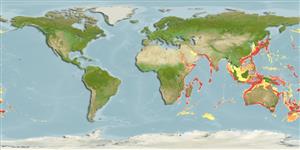Polychaeta |
Terebellida |
Pectinariidae
Environment: milieu / climate zone / depth range / distribution range
Ecology
Sessile; depth range 10 - 1500 m (Ref. 86801). Tropical
Indo-West Pacific.
Length at first maturity / Size / Weight / Age
Maturity: Lm ? range ? - ? cm Max length : 3.0 cm BL male/unsexed; (Ref. 80356)
Found in shallow waters (Ref. 80356) to bathyal depths (Ref. 86801). In soft bottom sediments (Ref. 102541). Members of the family Pectinariidae are selective deposit-feeders (Ref. 87179).
Life cycle and mating behavior
Maturity | Reproduction | Spawning | Eggs | Fecundity | Larvae
Members of the class Polychaeta are gonochoric (sexual), gametes are spawned through the metanephridia or body wall rupturing.
Wehe, T. and D. Fiege 2002 Annotated checklist of the polychaete species of the seas surrounding the Arabian Peninsula: Red Sea, Gulf of Aden, Arabian Sea, Gulf of Oman, Arabian Gulf. Fauna of Arabia 19:7-238. (Ref. 2663)
IUCN Red List Status
(Ref. 130435: Version 2025-1)
CITES status (Ref. 108899)
Not Evaluated
Not Evaluated
Threat to humans
Harmless
Human uses
| FishSource |
Tools
More information
Population dynamicsGrowth
Max. ages / sizes
Length-weight rel.
Length-length rel.
Length-frequencies
Mass conversion
Abundance
Life cycleReproductionMaturityFecunditySpawningEggsEgg developmentLarvae PhysiologyOxygen consumption
Human RelatedStamps, coins, misc.
Internet sources
Estimates based on models
Preferred temperature
(Ref.
115969): 6.4 - 17, mean 10.2 (based on 818 cells).
Fishing Vulnerability
Low vulnerability (10 of 100).
